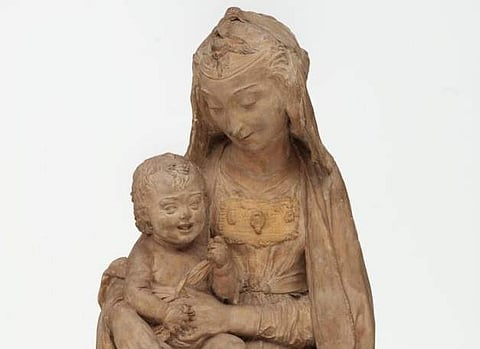
- LIFESTYLE
- FASHION
- FOOD
- ENTERTAINMENT
- EVENTS
- CULTURE
- VIDEOS
- WEB STORIES
- GALLERIES
- GADGETS
- CAR & BIKE
- SOCIETY
- TRAVEL
- NORTH EAST
- INDULGE CONNECT

Rome, March 9: Italian curators have unveiled what they believe is the only surviving sculpture by Leonardo da Vinci at an exhibition in Florence, a media report said on Saturday.
It's always been part of da Vinci's legend that he made sculptures, including a giant horse, but not a single extant three-dimensional work by him has been identified, reports said.
The 50 cm-tall red clay sculpture called The Virgin with the Laughing Child is the miraculous exception, according to the curators of the exhibition Verrocchio: Master of Leonardo, at Palazzo Strozzi.
It is said to have been created by da Vinci around 1472, when he was 19 or 20 and a pupil of the Florentine artist Andrea del Verrocchio.
The sculpture has been in London's Victoria and Albert (V&A) Museum since 1858, but had been credited to another artist, Antonio Rossellino, according to Francesco Caglioti, the Italian academic who is leading the new attribution.
Victorians had no difficulty seeing the Leonardo-esque look of the V&A treasure, Caglioti said.
The Virgin Mary looks down at the child Christ on her lap with what may be the prototype of all the enigmatic smiles in da Vinci's art, the most famous of which is the Mona Lisa's.
Late art historian and British Museum director John Pope-Hennessy pronounced that the sculpture was by Rossellino, but he had no real evidence for his ruling, claimed Caglioti.
Revered da Vinci scholar Carmen C Bambach, from the Metropolitan Museum in New York, has also supported the claim, said the report.
They focus on two crucial details: First, the voluminous, complicated draperies that flow over the Madonna's legs are similar to drawings of draperies da Vinci was making at the time, Bambach said.
Second, there's the face of baby Jesus Christ and his realistic, well-observed pose. He looks alive. That same attention to young children's actual behaviour can be seen in da Vinci's drawings, the scholar added.